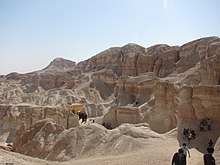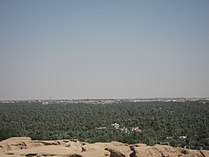Al-Ahsa Oasis
[6] Al-Ahsa is the plural form of "Al-Ḥisā" (Arabic: ٱلْحِسَى) which refers to a landscape of accumulated sand with an impermeable layer underneath.
When rain falls onto such a landscape, the water soaks through the sand (which prevents it from evaporating) and is retained by the impermeable base layer, forming an aquifer.
[9] Natural fresh-water springs have surfaced at oases in the region for millennia, encouraging human habitation and agricultural efforts (date palm cultivation especially) since prehistoric times.
[10] The oasis region and specifically the name Hajar (also Hagar, Haǧar) may be related to the Ancient Near East toponym Agarum, mentioned in Dilmunite inscriptions as the original home of their chief deity Inzak.
In 899 the region came under the control of the Qarmatian leader Abu Tahir al-Jannabi[13] and was declared independent from the Abbasid Caliphate of Baghdad.
Al-Ahsa subsequently fell under the rule of the Bahrani dynasty of the Usfurids, followed by their relatives, the Jabrids, who became one of the most formidable powers in the region, retaking the islands of Bahrain from the princes of Hormuz.
Al-Ahsa, along with Qatif, was incorporated into the Wahhabist Emirate of Diriyah in 1795 but returned to Ottoman control in 1818 with an invasion ordered by Muhammad Ali of Egypt.
The result of the meeting was the Uqair Protocol of 1922, in which Britain recognized ibn Saud's sovereignty over territories claimed by the emir of Kuwait.
Al-Ahsa was taken from the Ottomans in 1913,[21] bringing the Al Sauds control of the Persian Gulf coast and what would become Saudi Arabia's vast oil reserves.
[citation needed] Al-Ahsa is part of the region known historically for its high skill in tailoring, especially in making bisht, a traditional men's cloak.
[citation needed] The oasis is a popular tourist destination for Qatari nationals, who would make the 160-km cross-border drive to visit local attractions, as well as to find bargains for food, spices and clothing in Al-Ahsa's bazaars.



